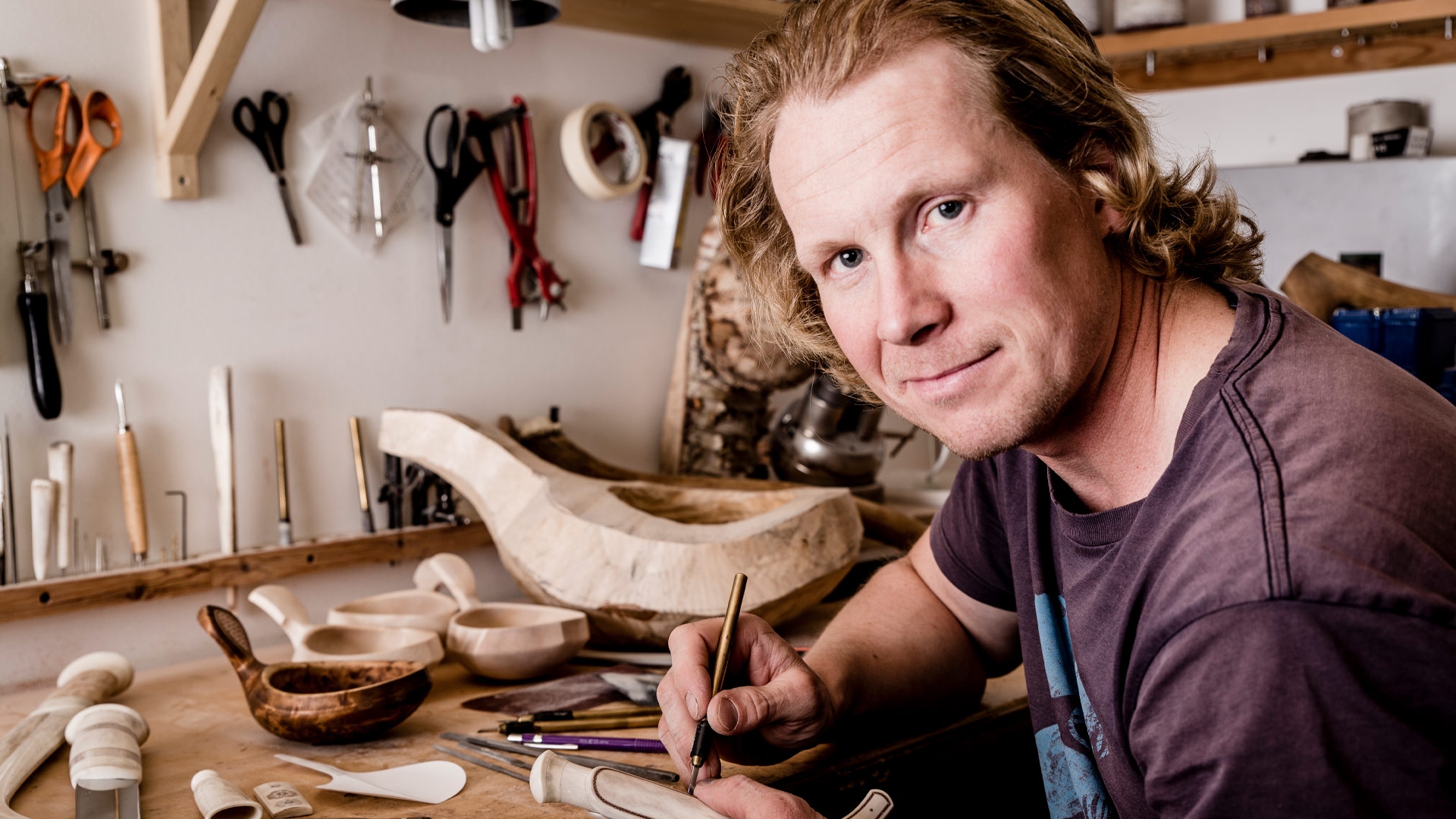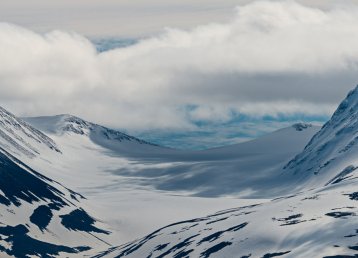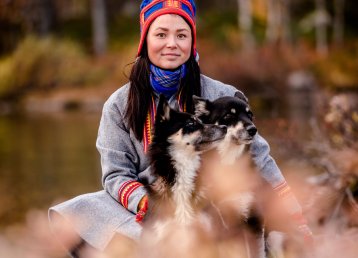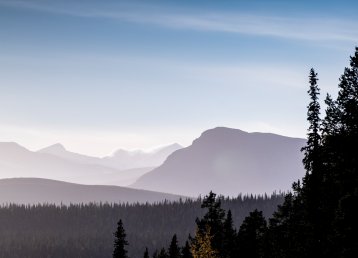At Nutti Sámi Siida in Jukkasjärvi, a reindeer named Bulmmot eats from my hand. I have a handful of fodder pellets, and Bulmmot seems to like them about as much as I like a bag of candy. Bulmmot is North Sámi for ‘grey sparrow’. His coat, in different nuances of grey, is the same colour as the little bird. A castrated bull, he is also named for the grey sparrow because he is small, lazy and a bit fat. His attitude is also similar to that of a grey sparrow.
Nils Torbjörn Nutti
There are about 20 reindeer in Nils Torbjörn Nutti’s paddock in Jukkasjärvi. All have names, and each is named according to their disposition, appearance, or significance for Nils Torbjörn. Here, we meet Linis and Girjak, and Dábaláš, meaning common, which seems a little unfair. Dábaláš is beautiful. We also meet Áddjá Muzet, ‘great-grandfather’s dark-brown’, the last reindeer to bear his grandfather’s earmark before Nils Torbjörn took over the herd. The Sámi language is very descriptive.
My pet’s name, Frasse, reflects the limited extent of my imagination. But the name Bulmmot reflects the animal’s character and personality. When the pellets in my hand are all gone, Bulmmot wanders off, back to the herd, where he is happy. That’s not unusual. Your dog, who you love more than you can imagine, will still be happier in the company of other dogs. Humans’ relation to domestic animals is always different than the animals’ relation to their human masters. It’s just that we don’t understand it. But for the Sámi, the reindeer is not merely a domestic animal, a pet or a companion; it is the foundation upon which their culture and lifestyle are based. There is a promise between the Sámi and the reindeer; they will care for each other for all eternity.
Ingrid Pilto
At home in her kitchen, Ingrid Pilto is preparing blood dumplings. The autumn slaughter provides quite a lot of blood and fat. “Healthy fat,” as Ingrid is quick to point out. The fat of the reindeer is part of an eco-cycle unto its own. The animal fattens up in spring and summer, only to lose its fat during winter. This explains why it is healthy; few toxins accumulate in the reindeer’s fatty tissue. Some even believe it is better to cook with reindeer fat than with olive oil or rapeseed oil. The ratio of Omega 3 to Omega 6 is also optimal. Naturally, and furthermore, the fat is a natural flavour enhancer.
While the blood dumplings cook, Ingrid prepares a thin membrane of caul, which surrounds the innards. This is for a gurpi, a sort of crépinette, which Ingrid will make later. The gurpi, from the Sámi word gurpat, meaning ‘to tie together’, is a kind of sausage made from minced reindeer meat, and lightly smoked and frozen so that it can be conveniently taken on a trip.
The art of cookery
In recent years, both gurpi and suovas (salted, lightly smoked reindeer) have become best sellers. Suddenly, tastebuds the world over have become enamoured with the old ways of preserving and preparing meat. On the menus of leading eateries, smoking, drying, and pickling are all the rage.
Ingrid expertly carries the traditions forward. Her poached sea trout is a classic. Her gurpi differs from all others. If it is seasoned, it certainly isn’t with something you’d find on the grocer’s shelf. Ingrid maintains high standards when it comes to Sámi fare. With reindeer meat, she eschews seasonings. The meat is cold-smoked which, together with the crépinette, gives the gurpi its flavour.
“Suddenly, tastebuds the world over have become enamoured with the old ways of preserving and preparing meat.”
All reindeer meat differs in flavour from one season to the next. Summer reindeer, from animals that have eaten almost nothing but grass, is particularly mild. Meat from bulls that have been slaughtered in the autumn is richer since the animals have begun to eat wild fungi, which imparts more flavour to the meat. Meat from the winter slaughter is the gamiest. This is because fodder is scarce and the animals have foraged for lichens. A bearer of tradition, Ingrid is a Sámi home cook who knows the secrets behind good food. And she knows that it is both possible and necessary to develop the art of cookery.
There are several aortas in a bucket on the front porch. They remind me of the over-cooked pasta that they served us for school lunches. In the old days, the Sámi boiled aortas and ate them, just as they are, like spaghetti. Nowadays, explains Ingrid, when battered and deep-fried, they are a bit like calamari in terms of both taste and consistency. My mouth begins to water.
Also read
Sápmi slow food with Ingrid PiltoSámi cooking
Sámi cooking is changing and, of course, there are modern versions of all the dishes, but the reindeer remains the same. From this animal, which is the heart and soul of this cultural identity, everything must be used, and nothing discarded. English celebrity chef Fergus Henderson helped to popularize ‘whole beast’ or ‘nose-to-tail eating’ at his Michelin-starred restaurant St John in London. In the words of Fergus Henderson, “If you’re going to kill the animal, it seems only polite to use the whole thing.” But this is nothing new. Making use of the whole animal has always been the number one rule in a society of hunter-gatherers. I don’t believe for a minute that the French would have eaten snails, oysters or woodcock with the innards if the freezer had been full of corn-fed fillet steak. Only in our careless, throw-way consumer society is it acceptable to prefer chicken breasts to thighs.
– Just imagine if everyone ate the way we do, says Ingrid, looking at me intently.
– I don’t think we can afford it, I reply, laughing. You know, ptarmigan and arctic char don’t come cheap.
– No, that’s not really what I mean. I mean, like Per-Nils and I, we use everything and do the cooking ourselves.
“For the Sámi, the reindeer is no throw-away item. Hides were tanned for clothing, sinews became sewing thread, antlers were ideal for knife handles and other tools, and the hooves were boiled for glue. Nothing was worthless; everything had a use.”
I understand what she means. But it’s sometimes good to be reminded. Have you ever eaten the muzzle? Or blood pancakes made from dried reindeer blood that has been dried in an inside-out stomach before being mixed into the pancake batter? For the Sámi, the reindeer is no throw-away item. Hides were tanned for clothing, sinews became sewing thread, antlers were ideal for knife handles and other tools, and the hooves were boiled for glue. Nothing was worthless; everything had a use.
Shed antlers. Not only the fat of the reindeer is part of a cycle, so are the antlers. The bulls shed their antlers in late autumn. Neither blood nor energy is lost through the antlers in the cold of winter. The cow, the female, however, keeps her antlers. This allows her to protect her offspring from predators and keep antlerless bulls away from her fodder.
Jon Tomas Utsi
Craftsman Jon Tomas Utsi sits in a workshop in Porjus working on an engraved piece for a bone-handled knife. Jon Tomas has crafted traditional Sámi artefacts all of his life, as did his forefathers. He began selling his works at the Jokkmokk winter market at the age of ten. In Jokkmokk, he studied his craft and later became a teacher at Samiska Folkhögskolan for a while. Here, in Jokkmokk, his works are always exhibited at the Ájtte museum during the market. Jon Tomas gathers all of the materials himself, and he works mostly in burl*, curly birch and reindeer antler, of course. We chat about reindeer antler, and I am a little surprised when he says that he only works with shed antler and that it makes no difference if it has been lying on the ground.
– How do you mean? Isn’t it degraded by the elements?
– No; in fact, it isn’t. The antlers just get a bit more patina. Of course, there’s a limit to how long they can be exposed to the weather and wind, but that just gives the material more character.
“This type of art, crafted from recovered shed reindeer antlers is a beautiful form of recycling and sustainability.”
Jon Tomas’s family were forced to move from Karesuando in the early 1900s. His great-grandfather brought his herd and his children to Vájsáluokta in Sirge village. While he combines different traditions, Jon Tomas has also added his own individual touch. His work is Sámi duodji, genuine Sámi craftsmanship, and his engravings and ornamentation also follow Sámi tradition. In addition, he decorates his knives with fantastic reindeer motifs. Since his youth, this type of art, crafted from recovered shed reindeer antlers, has been his principal source of income. This is a beautiful form of recycling and sustainability.
* A burl is a tree growth in which the grain has grown in a deformed manner. Commonly found in the form of rounded outgrowths.
Lennart Pittja
A reindeer herd is a sort of matriarchy. A cow decides. It is the leader cow who knows, or decides, if the ice will hold and when it is time to migrate from the fell country to the lowlands. It is the leader cow who knows when it is time to return to the calving grounds in the spring. The leader guides her herd through eight shifting seasons of the year.
I tell my good friend, reindeer herder, Lennart Pittja, that I think it is a little strange that the female is clearly the leader of the herd but, where people are concerned, the Sámi world seems to be more of patriarchy.
– Yes, we haven’t quite progressed that far yet, says Lennart, laughing.
– That’s a rather interesting thought. On the other hand, we need to be honest; patriarchy is a product of the agrarian society, stemming from a time when families had many children. Perhaps we Sámi were the last to live that way.
– Indeed, that is probably the case, but I really just said it as a passing remark. No harm intended I say, trying to let it pass.
– I know, but an entire life of ‘passing remarks’ might make some of us a bit sensitive, counters Lennart.
I understand him. At his home in Gällivare, we sit in silence. We have to be careful with our words.
The apartment in Gällivare is hardly Lennart’s real home. Instead, it is merely a place to stay, because the ‘modern world’ demands it. The kids have to go to school, forms have to be sent to the tax authorities, the car has to be taken in for motor vehicle inspection, and the hairdresser is fully booked before Christmas. The list goes on and on. We drink our coffee.
Sårkåjaur
I place a bit of meat in my cup. Lennart smiles. Sårkåjaur, near the Norwegian border, where Lennart’s Sámi village Unna Tjerusj has its calving grounds, is where he really feels at home. A few years ago, we met at the Jokkmokk market. It had snowed heavily that winter and the spruce bows were hanging low under the weight. Every tree in the forest was white with snow. I remarked at the beauty of the landscape. Lennart said that he was very concerned about what it would mean for the reindeer. I stood there like an idiot. It occurred to me that the reindeer probably didn’t care about the lovely scenery. But if they did, they wouldn’t complain about the spectacle. A forest becomes a cathedral of light. Lennart explained that the snow on the trees covered the lichen. And when the reindeer ate the lichen, they ingested mostly snow and water but not very much lichen. Although their hunger may have been stilled, they would derive little energy.
Several weeks later I read that many reindeer had succumbed to starvation that winter. I thought of Lennart. How sad he must have been. He didn’t need to hear any passing remarks, like ‘there’s always some problem with the reindeer. Either there’s too much snow or too little’. I thought of calling him to offer my condolences. I never did.
Also read
Stories told with namesA hymn to home
Lennart Pittja runs the award-winning eco-lodge Sápmi Nature Camp in the Laponia World Heritage in Swedish Lapland, on the grounds his sámi reindeer herding community Unna Tjerusj has inhabited for generations. The island up in Sårgåjávrre is the summer grazing land for the reindeer, the place where Lennart fish his fish, and the place he calls home.
The reindeer
There is no adequate way of explaining what the reindeer mean to the Sámi. In an age of consumerism and credit institutions, the reindeer don’t quite fit in. Perhaps, for the sake of comparison, I could liken the reindeer to oil in a petroleum-based economy. But that is a rather simplistic view of something so beautiful. It would reduce us all to neurotic consumers. For the Sámi people and the Sámi culture, the answer is so much more complicated. The reindeer, its habitat and its migration have given rise to the entire Sámi culture and, thereby, even Sápmi, the Sámi homeland.
A nomadic people, the Sámi followed the reindeer over a yearly cycle of migration between the high country and the coast. An eco-cycle over the eight seasons. Gijrra is the most important season. This is the time of calving when the continuity of life is reaffirmed. Calving is central to the Sámi culture, much like the resurrection is to Christianity. If you studied religion at school, you know what I mean. After gijrra comes gijrragiessie, spring-summer, the season that can’t quite make up its mind. Is it late spring or early summer? One minute it’s cold, the next it’s warm. Always sun, always greenery, everywhere.
The seasons
Giessie, of course, is summer as we know it. Apart from the task of earmarking calves, it is a time to rest and grow. Tjakttjagiessie is the harvest season when wild berries, mushrooms and game are gathered. It is the most beautiful of the seasons. Nature is decked out in her most colourful finery, the morning mist lingers over the lake, and the mercury no longer rises as high in the thermometer. Tjakttja comes at last. Leaves fall from the trees, snowflakes dance in the air and the reindeer know it is time to leave the calving grounds for the winter grazing grounds. A cold wind blows the snow here and there, and skis are brought out after three seasons in storage. Tjakttadálvvie, autumn-winter, is a time to gather at the fireside at nightfall, light the candles and huddle up under a warm blanket on the sofa. The year, like nature, enters into repose.
During Dálvvie, the change will come. Even so, it will be some time before we notice that the days are starting to grow longer. The winter cold still holds us tightly in its grip, but it slowly relaxes as Gijrradálvvie takes over, with all of its light and promises of a new resurrection. You manage to do more and more during the day. There’s time for a ski tour both before and after work. The light returns as does the lust for life. Soon, expectant cows will begin the migration towards the calving grounds again. The wheel has come full circle. The birth of the reindeer calf bears witness to its resurrection of life, which is really a cycle.
Carl-Johan Utsi
Carl-Johan Utsi is a photographer and reindeer herder in the Sirges Sámi village, whose lands include parts of Badjelánnda in Jokkmokk. He lives in symbiosis with his animals and his camera and with a foot in two worlds. There are at least two other Utsis who are professional photographers in Swedish Lapland. I ask Carl-Johan if they are related.
– Distantly, maybe. Among the Sámi, Utsi is very common. Many share the name.
– I didn’t realize that.
– No, of course.
Carl-Johan has studied engineering physics with specialization in space technology for five years at Uppsala University. Or, as he puts it, he has a ‘helluva lot of credits’. But, he says that his studies have benefited him more than he would have expected since he decided to return to reindeer herding.
– Studying involves problem-solving, but so does reindeer herding.
Visut
Carl-Johan says he wanted to get away, to rebel against the Sámi lifestyle. He thought he could be anything, do a doctorate, solve the fusion problem, and win a Nobel Prize. But, during a break in his fourth year of studies, Carl-Johan’s father said that his boy was doing so well in school that it might be time to sell the reindeer. That cut Carl-Johan like a knife; he’d never really considered it. He wasn’t prepared to lose that part of his life. His father promised to keep the reindeer for a couple of more years until Carl-Johan had graduated.
– Life in the reindeer forest is a feeling, but, at the same time, it is an absolute reality. I mean, when you get your snowmobile stuck in soavli – ‘water on top of the ice’ – out on the lake, and you have to struggle for a couple of hours, that’s just part of a normal working day in the life of a reindeer herder. Even so, there’s something else there as well, something we have in our genes.
– The reindeer is our strongest link with nature. That is my real connection with reality.
– Anyone can do a 9-to-5 job; where’s the challenge in that? But try succeeding at reindeer herding. It’s impossible if you don’t understand deep within your innermost being that you are totally dependent on that clacking sound, the sound of reindeer hooves. It’s almost metaphysical – something I cannot do without. Yes, for me, that sound is purely physical; the thought of not hearing it hurts.
“Visut is a North Sámi word. For me, it means 'everything I will ever want or ever need'.”
– Is that why you chose this – getting your snowmobile stuck in the slush, never knowing if the ice will freeze, the constant fear of accidents and trouble – instead of a career in space physics?
– I don’t know. It’s sort of weird and ambiguous. In the woods, there are no high demands or expectations; I simply want to be outdoors. And that feeling is wonderfully liberating. At the same time, it’s bloody difficult to make a go of it financially or business-wise.
– But you can’t do without it – or?
– It’s tough. But if you asked me what the reindeer means, my answer would have to be Visut.
– Visut; what does that mean?
– Visut is a North Sámi word. For me, it means ‘everything I will ever want or ever need’.

































